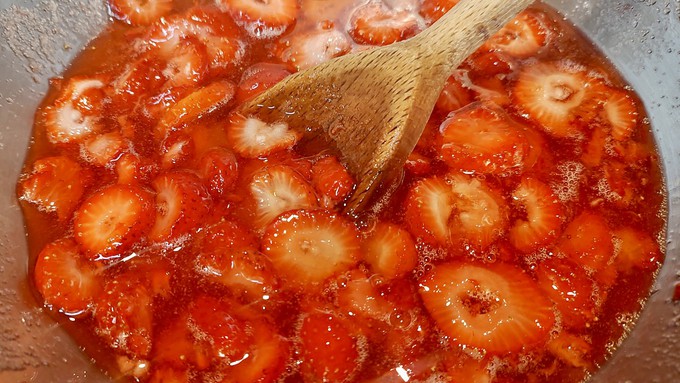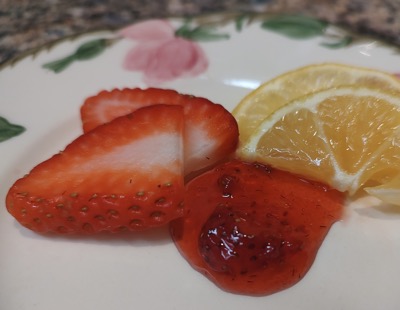
Recipe: Sunny strawberry-Meyer lemon preserves without added pectin

Strawberries macerate in sugar before they are quickly cooked into a small batch of lemony-sweet preserves. Debbie Arrington

Sometimes I have the urge to make jam but not too much – especially if I have limited fruit. These easy preserves take only 1 pound of strawberries, 2 cups of sugar and one Meyer lemon – no added pectin necessary.
Compared to jam, preserves have larger pieces of fruit – even whole small berries. Larger strawberries are quartered or sliced.
This recipe does take a little advance planning. To bring out their juice, the strawberries need to sit in the sugar for six hours (or overnight). This process helps the berries retain their bright red color.
Added just before cooking, the Meyer lemon juice and zest add a bright, sunny note to the berries.
The result is soft and spreadable. Keep the finished preserves in the refrigerator.
Sunny strawberry-Meyer lemon preserves
Makes about 1 pint (2 cups)
Ingredients:
1 pound strawberries, washed, hulled and quartered (about 2 cups)
2 cups sugar
Zest of 1 Meyer lemon
2 tablespoons Meyer lemon juice
Instructions:
In a large stainless steel or non-reactive bowl, mix strawberries with sugar. Cover and refrigerate for at least 6 hours (or overnight), stirring occasionally.

Transfer berries, sugar and syrupy juice to a large heavy pot. (It needs room to bubble.) Add lemon zest and juice.
Over high heat, bring strawberry mixture to a boil, stirring often so it doesn’t stick or burn. Let boil for 1 minute. Reduce heat to medium and let preserves simmer, stirring often, until desired consistency (about 10 to 15 minutes).
Remove from heat and transfer to a sterilized jar or other container. Cover and store in the refrigerator. May be frozen up to 6 months.
When is jam (or jelly or preserves) ready? To test consistency, freeze a small plate in the freezer for at least 10 minutes. Spoon a ½ teaspoon of preserves onto cold plate and return it to freezer. Check in 2 minutes. If the jam/jelly/preserves doesn’t run when the plate is turned sideways, it’s done.
Comments
0 comments have been posted.Sacramento Digs Gardening to your inbox.
Sites We Like
Garden Checklist for week of July 21
Your garden needs you!
* Keep your vegetable garden watered, mulched and weeded. Water before 8 a.m. to reduce the chance of fungal infection and to conserve moisture.
* Feed vegetable plants bone meal, rock phosphate or other fertilizers high in phosphate to stimulate more blooms and fruiting. (But wait until daily high temperatures drop out of the 100s.)
* Don’t let tomatoes wilt or dry out completely. Give tomatoes a deep watering two to three times a week.
* Harvest vegetables promptly to encourage plants to produce more. Squash especially tends to grow rapidly in hot weather. Keep an eye on zucchini.
* Pinch back chrysanthemums for bushy plants and more flowers in September.
* Remove spent flowers from roses, daylilies and other bloomers as they finish flowering.
* Pinch off blooms from basil so the plant will grow more leaves.
* Cut back lavender after flowering to promote a second bloom.
* It's not too late to add a splash of color. Plant petunias, snapdragons, zinnias and marigolds.
* From seed, plant corn, pumpkins, radishes, winter squash and sunflowers.